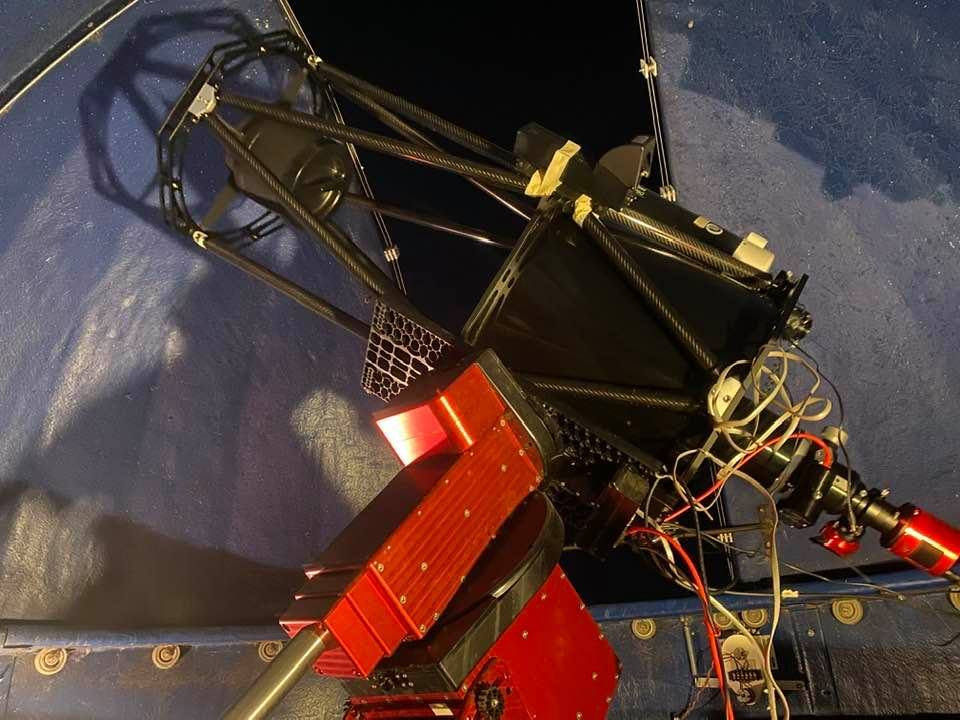Astronomical Society Buys New, Advanced Telescope
- Share
- Tweet
- Pin
- Share

In early April, the Door Peninsula Astronomical Society (DPAS) ordered a telescope that “might be the most advanced one in northeast Wisconsin,” vice president Tom Gwilym said.
Replacing the society’s four-year-old GSO Ritchey-Chrétien optical tube is its new PlaneWave Instruments CDK400 observatory system. It arrived May 31, and DPAS members hope to have it fully operational in time for a Sept. 24 public showing.
The CDK400 is “almost research grade,” used in universities and major cities across the country, Gwilym said. The price tag was around $78,000, including installation and all of the necessary equipment, and it was funded by DPAS’s late founder, Ray Stonecipher.
Stonecipher, who died in 2015, left estate money to the society, which funded the Ray and Ruthie Stonecipher Astronomy Center and the equipment in it, and it continues to fund improvements, including the CDK400.
Out with the Old, In with the New
The CDK400 is well equipped for Wisconsin weather, Gwilym said, with temperature-resistant glass that allows for accurate focus even at extreme temperatures. On winter nights when it’s too cold to visit the astronomy center, Gwilym said the internet-controllable CDK400 can be operated remotely.

The new telescope is not currently operating at full capacity because DPAS is waiting for a custom-made part to help its focus. But once that arrives, Gwilym said the CDK400 will be much easier to use than the society’s old telescope, the Ritchey-Chrétien. It was a quality telescope, but it was difficult to work with, needing constant readjustments so it could focus, Gwilym said. For this reason, DPAS has been considering an upgraded telescope since February.
In addition to being easier to handle, the CDK400 will show higher-quality images of more distant astronomical objects, so stars and galaxies that appeared blurry on the Ritchey-Chrétien will show up more clearly.
It will be able to take pictures of these objects more accurately, too, and share live images to an 80-inch flatscreen TV at the Stonecipher Astronomy Center.
Once the CDK400 is fully operational, Gwilym is excited to look at Stephan’s Quintet galaxy cluster, which was featured in some of the first pictures from the James Webb space telescope.
“We need to give them some competition,” Gwilym said jokingly.
The Stonecipher Astronomy Center already draws astrotourists, and the quality of the new telescope could bring more, Gwilym said. That might be because Sturgeon Bay and the Door peninsula have darker skies than many of the cities where visitors live, and Newport State Park was named an International Dark-Sky Park in 2017.
A Threat to Door County’s Dark Skies
But Door County isn’t immune to light pollution, and Gwilym has seen city development exacerbate the problem since he moved to the area in 2018.
“Four years ago, I could see the Milky Way from my front yard,” Gwilym said. Now, it’s still visible, but the southern part has faded noticeably.
Gwilym has fought to keep Door County’s skies dark, successfully pushing back against a billboard that pointed lights toward the sky and creating a Facebook page to spread awareness about local light pollution. Last year, he was named an International Dark-Sky Association advocate for his conservation efforts.
“Even larger cities can keep their skies dark” with the help of strict lighting restrictions, Gwilym said, citing Flagstaff, Arizona, as an example.

Upcoming Events
DPAS hosts monthly public viewing nights, when society members help the public locate astronomical objects with telescopes, binoculars and laser pointers. If the weather is poor for viewing, electronic tours are held in the planetarium.
Gwilym hopes to have a “grand opening” for the new telescope, tentatively set for Sept. 24. Other viewing nights are planned for Oct. 22, Nov. 19 and Dec. 17 – all at the Stonecipher Astronomy Center, 2200 Utah St. in Sturgeon Bay.
